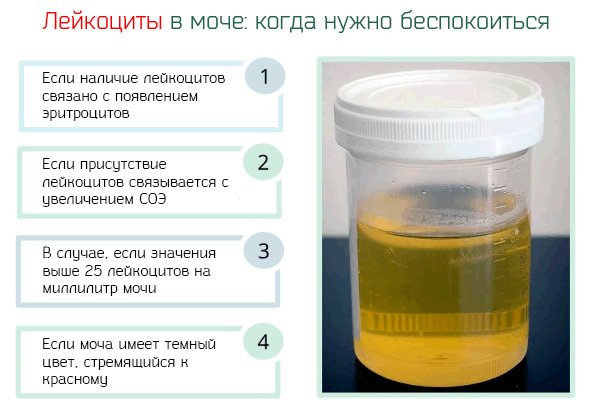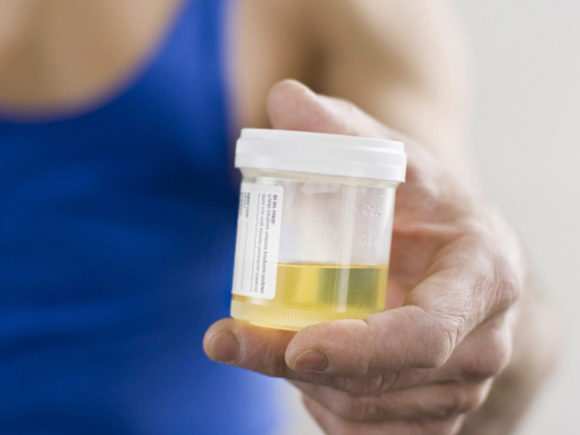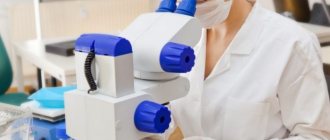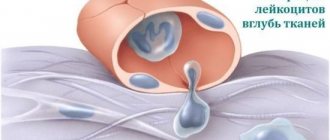If, during testing, leukocytes were detected in the child’s urine, it means that a disease is occurring in the body, which is important to identify for timely treatment. High levels of leukocytes in a child’s urine are accompanied by characteristic symptoms, in which one should not hesitate or self-medicate, but urgently take the baby for examination. What reasons provoke an increased number of leukocytes in the urine, how to treat the disease, and what preventive procedures will help avoid recurrence?
Preparing for a urine test for leukocytes in a child
In order for the test results to give the most accurate results, it is important to properly prepare the baby for the procedure, following all the doctor’s recommendations and instructions. To ensure that the urine does not have unnecessary uncharacteristic inclusions and does not have a suspicious color, 2-3 days before the test you need to adhere to a diet that excludes foods that affect the color of urine, as well as dishes that provoke an increase in certain indicators in the urine.
In an infant, urine can be collected in a sterile container using a urinal; in older children, urine is collected, as in adults. In order for a urine test to show correct results, you need to collect morning urine, take the middle portion, and pour the first drops into the toilet. Urine must be collected in a sterile container, which you can prepare yourself or buy at a pharmacy. If you do not adhere to the rules for collecting urine and do not carry out hygienic procedures for the child, then the leukocyte level may be 50-60 units.
What are the symptoms of elevated leukocytes?
Caring for infants is especially difficult because they are unable to articulate the symptoms that are bothering them. The task of doctors is to timely identify diseases through tests, for which parents need to monitor all urination in newborns. The child's nervous behavior in this case or any changes in quality or volume require special attention and may be a symptom of pathology.
Pathologies or leukocytes in the urine can be detected by a changed shade of urine, temperature, nausea, poor general health, and vomiting. Taking tests can confirm or refute suspicions of the disease.
Causes of increased blood levels
Frequent fatigue, general malaise, increased body temperature, and lack of appetite are symptoms that require you to consult a doctor. An increase in white blood cells may also be accompanied by weight loss, dizziness, decreased visual acuity, and sweating. Infants are often capricious and refuse to eat. Their sleep patterns are disrupted and their stomach hurts.
There are many reasons for deviations from the normal number. Let's consider the main factors that provoke these abnormalities in the blood:
- stress, nervous breakdowns;
- infections;
- allergy;
- parasites;
- burns, injuries, postoperative period;
- anemia;
- poisoning;
- disruption of the endocrine system;
- bleeding;
- sepsis;
- chronic diseases;
- presence of cancer.
The quantitative indicator of white blood cells may rise in case of diseases of the cardiovascular system, for example, heart disease. Physiological reasons include the premenstrual state of older girls, outdoor games, sports, physiotherapeutic procedures, and visits to the X-ray room. Taking certain medications can also change the indicator.
These reasons cause a protective reaction of the body. To combat negative factors, the number of leukocytes in the blood increases.
If the indicator has changed for physiological reasons, it will return to normal on its own. Pathological processes that change the composition of the blood require treatment.
Normal for girls and boys
The norm of leukocytes in the urine of a newborn baby and a one-year-old child exceeds the indicators of older children, and ranges from 8-10 units in girls, slightly less than 5-6 in a boy. If the baby is 1-3 years old, there are no inflammatory processes in the body and the child is healthy, then the number of leukocytes is 2-3 units; at 3 years and older, leukocytes in the urine are 11. In adolescents, the red corpuscle in the urine is present in smaller quantities and fluctuates in the range of 1-2 units. There are different methods according to which the indicators will fluctuate by several units, which is why there is confusion in the interpretation of the results. Thus, when taking urine tests according to Nechiporenko for children, the norm is 2-4 units, and according to the Addis-Kakovsky method, the normal value should not exceed 2 units.
If the urine test exceeds the norm of leukocytes, this indicates that diseases are occurring in the body, which provoke changes in indicators.
Reasons for the increase
The reasons for the fact that completely elevated leukocytes are found in the urine of children are very diverse, but most often the root cause is a severe inflammatory disease. For example, with pyelonephritis, a child’s urine analysis shows leukocytes of 20-30 units, while bacteria are visible in the urine, protein also exceeds normal levels. This is a large excess of the norm, so urgent medical attention is required. Such indicators can occur in acute forms of cystitis or urethritis, so in no case should you give your baby medicine yourself.
The reasons for the increase in leukocytes in the blood and urine are congenital pathologies of the development of the organs of the genitourinary system. Allergies also affect test results, so if a child suffers from such a pathology, then 40-50 leukocytes may also appear in the results. Even if the baby feels normal and does not have a fever, and there are a lot of leukocytes in the urine, this is also a reason to visit a doctor.
Why do babies have leukocytes in their urine?
In newborns, a certain number of leukocytes are always present in the urine excreted. What does this mean for the child and is there a danger to life? The indicator is considered acceptable at 7 units in the field of view for boys and 10 for girls.

The minimum indicator for both sexes is at least 3 leukocytes in the field of view of a laboratory microscope. Deviations in the form of an increase in these indicators can appear with stagnation of urine, which means inflammation of the genital organs and urinary tract infections.
Not in all cases, pathology is detected only by leukocytes in urine. Their presence may have physiological reasons. For example, if there are abnormalities in the structure of the organs of the genitourinary system, then white blood cells may also be enlarged. The anatomical pathologies of urine excretion may have pathologies in the form of expansions or contractions, which provokes leukocyturia due to stagnant processes in these places.
Why do infants have white blood cells in their urine?
Infants often have inflammation, the manifestation of which is pustules in the affected areas. Sometimes, when teeth first appear, white blood cells in the urine also grow rapidly, especially if pustules burst and pathogenic microorganisms are released from this cavity. Leukocytes are responsible for the destruction of pathogenic bacteria, being a natural barrier to their development.
Leukocytes increase in the body with genital diaper rash, cystitis and urethritis, enterobiasis and allergic reactions, inflammation in the kidneys and metabolic failure. For boys, there is another reason - inflammation of the foreskin, when white blood cells enter the urine collected for analysis during urination.
More on the topic: Basic functions of the bladder
Protein and leukocytes in the urine of newborns
In some cases, a protein is detected along with leukocytes, which is included in the analysis for inflammation in the kidneys and urinary tract. Albumin is the most frequently detected protein in newborn tests. The reason may also be the baby’s poor diet. Doctors often prescribe repeated donation of biomaterial to rule out pyelonephritis.
Detected proteinuria occurs with elevated temperature, infectious disease, stress or fatigue. There is no need to sound the alarm when protein appears; it is enough to go through the test again and identify the true cause of this phenomenon.
Bacteria and leukocytes in the urine of newborns
Bacteria are often found in the urine of infants, which penetrate through the ascending or descending routes into the reproductive system. If the bacteria count is above 105 g/ml, this will indicate bacteriuria. The danger of this disease not only for infants, but also for adults in the environment lies in the damage to the kidneys of nearby people upon contact with pathogenic microorganisms.

The reason is most often physiological in nature, when the rules of intimate hygiene of the child are violated. In this case, E. coli and other bacteria develop, entering the urethral canal and causing infections in the genitourinary system. Damage is also possible if the rules for sanitizing the genital organs are violated when collecting urine for analysis. The remaining cases of bacteria appearing on tests indicate urological diseases of the urinary system and kidneys, in which inflammation appears.
Signs of leukocytes in urine
- difficulty urinating;
- baby crying while emptying the bladder;
- cloudy urine with sediment or flakes;
- urine has an unpleasant odor;
- dark colored urine;
- elevated temperature;
- the occurrence of chills.

If you suspect an increased level of leukocytes in your child’s urine, you should contact your pediatrician. The norm, exceeded even by the slightest, can become a cause for concern about the baby’s health.
What do elevated white blood cells in a child’s urine mean?
If a child has elevated leukocytes in the urine, this indicates inflammation in the kidneys, bladder, ureters or genitals. The largest number of leukocytes (mononuclear) is observed with kidney inflammation and pyelonephritis.
When their increased content appears in a baby, the main reasons are the following pathologies.
- Ureteral infections. Stagnation leads to infection and leukocyturia.
- Cystitis. Inflammation of the bladder due to bacteria. In girls, cystitis occurs more often due to anatomical features. Stagnation of urine also contributes to inflammation.
- Pyelonephritis. Infectious damage to the kidney very often begins in children with inflammation of the bladder, then spreads, reaching the kidney. In children with weakened immune systems, this disease occurs more often, and if not treated correctly, it can become a chronic disease.
- Inflammation of the mucous membranes of the genital organs. The kidney microflora penetrates the mucosa, so leukocytes increase their activity to destroy the infection and, together with mucus, enter the urine. Also, poor genital hygiene leads to inflammation and diaper rash.
- Glomerulonephritis is inflammation of the kidney glomeruli. It is not only infectious, but also partly allergic in nature, so leukocyturia of this origin has one characteristic feature - mainly cells of the eosinophilic type are released, and not neutrophils, as in other inflammatory processes. Glomerulonephritis can also become chronic, so it also needs to be treated urgently.
- Allergies. They are also characterized by an increase in inflammatory factors and an increase in cells, especially eosinophils.
- Stones in the kidney and ureters. Even in children, salts can be deposited and urinary stones can form in the kidney and ureters. This causes inflammation, infection often occurs, therefore, leukocytes increase.
When there are up to 15-20 leukocytes in the urine, they speak of leukocyturia. If their number is very increased, then the term “pyuria” is used. It is used when the content of leukocytes and pus in it is very high, it changes color and consistency (cloudy, sediment).
Symptoms of the disease
If a small child or teenager has increased leukocytes in the blood, such indicators mean that inflammatory processes are progressing in the body, which manifest themselves with similar symptoms:

- temperature and deterioration of general health against the background of intoxication of the body;
- painful trips to the toilet, during which the volume of urine is limited to a few drops;
- visualization of inclusions, which may be bloody, purulent or white mucous, when urinating in urine;
- a sharp deterioration in health if the inflammation is advanced and spreads to the kidneys (the child becomes ill, he may lose consciousness or become delirious);
- white coloration of urine, which indicates severe damage to the kidneys by the microbacterium tuberculosis, therefore, with such a symptom, you urgently need to take the baby for examination.
About leukocytes in urine and blood
Authors : Shcherbina E. A.
Scrolling through the latest posts in the “Questions about Children’s Health” group, I quite often come across questions of this type:
“This morning the child looked at me in a bad way, in an angry way. I decided to take the OAM, and there were all white blood cells! Is this pyelonephritis??? Will he live??? How to treat THIS???”
Or:
“The child has been snotty and coughing for five days now. The first three days there was fever and weakness. Now she feels much better, but today we passed the UAC, and there were TEN STICKS!!! What antibiotic will you recommend to us and where to insert it???
Py.Sy. And if I’ve already inserted it in the wrong place, how can I get it out of there???”
Let's figure it out. So, you've probably heard that the body has such a tricky thing as immunity. And there is such an important component in this immunity as leukocytes. The main task of leukocytes is to protect the body from everything foreign.
There are different leukocytes: granulocytes (neutrophils, eosinophils and basophils) and agranulocytes (lymphocytes and monocytes). Neutrophil leukocytes, in turn, are divided into rod-nuclear (snots, “green newbies”), segmented (Chuck Norris weeps bitter tears) and several other younger types of cells, which are found in the blood extremely rarely and are not related to our topic. The bloodstream contains only a small number of mature cells (segmented neutrophils). 20–40 times more of them are found in organs - depots, the main of which is their place of formation, the hematopoietic bone marrow, as well as the spleen, liver, and capillaries of the lungs.
Neutrophils play a very important role in protecting the body from bacterial and fungal infections and a relatively lesser role in protecting against viral infections. That is why, if there is a need to destroy pathogenic microorganisms or suppress the “uprising” of conditionally pathogenic ones, segmented neutrophils strive to fight, which inevitably leads to an increase in their number both in the blood (OAC) and directly at the site of inflammation (for example, TAM). If the strength turns out to be insufficient, young band neutrophils are called from the reserve, which, although they are “green newbies,” know how to hold a weapon with the right side.
Every second, real fighting takes place in some part of the body (they ate something, inhaled something wrong, etc.), which means that the migration of leukocytes in this case is simply inevitable. An even greater “mess” begins against the background of viral infections (most often ARVI), when the local immune system cannot cope with opportunistic bacteria that inhabit all parts of our body that come into contact with the environment.
And now the terrible secret! This entire immune system works constantly, independently and quite effectively. At the same time, you may not even realize it! You can take the OAM test while feeling absolutely normal, and they will find a lot of leukocytes there! You can detect an increased level of band neutrophils in a child’s clinical blood test on the 5th day of ARVI, but at the same time your child will be fading along the walls and ceiling worse than a badger man (or a spider?)!
Why am I saying all this? Moreover, in most cases, the immune system copes with bacterial infections on its own, without your attention - you don’t even realize that you have it! And the only way that allowed you to find out about this was UAC and OAM.
What should you do if you find signs of bacterial inflammation in the CBC and TAM against the background of an absolutely normal general condition? Nothing! Just watch!
What should you do if you find a slightly increased level of band neutrophils in a child against the background of ARVI, but at the same time he has obvious positive dynamics? Nothing! Just watch!
Additional research methods are called “additional” because they only help the doctor (adequate, of course) navigate the situation. A normal doctor will not treat tests! First, he will look for symptoms of the disease/complications and its other specific manifestations, and only then will he use laboratory data, but only to clarify! And if he discovers specific changes in the tests, but in the absence of a real “clinic”, then he will conclude that “here they can cope without me”...
A very important point: urine in children under 2 years of age should ideally be collected through a catheter or suprapubic puncture, because if it is collected using a jar or urine collector, then in 80% of cases you will get a false-positive result even in an absolutely healthy person child. For children over 2 years old or those who can control urination, you need to take a MEDIUM portion of urine, that is, the one that comes directly from the bladder!
Page of Shcherbina E.A. in ClubCom
published 02/07/2015 16:40 updated 10/03/2016 — Tests and examinations, Popular medicine
What are leukocytes?
Leukocytes, or white blood cells, are cells of the human immune system. They are round or irregular in shape and vary in size. These white components of the blood are called the main protective factor in the body’s fight against various diseases. Leukocytes contain special enzymes that are able to “digest” foreign microorganisms and break down decay products formed during human life. Some types of bodies produce antibodies - special proteins that destroy pathogenic bacteria, viruses and other microorganisms that enter the body. The place of their formation and maturation is the bone marrow. Leukocytes in newborns are determined in blood and urine tests. There are standards for this indicator for children of different ages.
Treatment of leukocyturia in a child
After all the tests have been completed and the diagnosis is confirmed, the doctor prescribes drug therapy. If the root cause of leukocyturia is an infectious disease, then mandatory antibacterial therapy is required, the duration of which should be at least a week. Additionally, painkillers, diuretics, and uroseptics are prescribed, which normalize the functioning of the kidneys and prevent the stagnation of excess fluid in the body.

During this period, it is important to maintain bed rest, stay warm, eat bland food, and adhere to the drinking regime. When you have a fever, you need to drink warm herbal chamomile tea, unsweetened compotes, fruit drinks, and fresh juices. From food, it is recommended to eat light food with a minimum content of salt and other seasonings. The temperature in the room should be comfortable, and it is important to maintain the optimal level of humidity.
If all the rules are followed, the child’s condition improves within 3-5 days. If there is no improvement and the picture of the tests is bad, it is recommended to take repeated tests and undergo further examination. If the red cells in the analysis are elevated, this may also indicate the development of a dangerous disease such as leukemia. The red body begins to attack malignant cells, which means that in tests the number of leukocytes will be significantly higher than normal.
Urine collection in young children
It is difficult for children to prepare material for research before they reach the age of two; it is difficult for parents to explain the rules to their child.
Therefore, there are several tricks:
- In infants, especially newborn girls, it is most convenient to collect material in special adhesive urine collection bags. To prevent the urine bag from being pulled off from above, you can wear thick panties, pants or diapers.
- In children 1.5-2 years old who are accustomed to visiting the toilet, it is possible to use the so-called “grabbed” morning portion of urine, which is collected into a sterile container immediately after the start of urination.
- Before gluing the urine collection bag, the external genitourinary organs are toileted according to the same rules. The bag should be removed immediately after urination is completed.
- If no urination occurs within 30-60 minutes of gluing the bag, it should be replaced with a new one.
- Urine collected using adhesive bags is suitable for OAM using test strips, but should not be used for culture.
- Urination in infants is often interrupted and occurs in small volumes. Therefore, it is possible to use several sterile urine bags in a row. To do this, immediately after finishing urination, the bag is immediately removed and the contents are poured into a sterile container. Then the baby should be washed a little with water, blotted with a clean towel and a new clean bag should be glued on. The process can be repeated until the required volume of material for research is collected.
A high level of leukocytes in a child’s body is an alarming signal that requires immediate response. The reasons may be quite harmless, but in most cases we are talking about the development of pathologies, including quite severe ones.
Prevention
Preventive measures should primarily be aimed at preventing relapses and improving the protective properties of the child’s body. Much attention needs to be paid to maintaining the baby’s personal hygiene. Girls need to be washed so that microorganisms from the anus do not fall on the outer labia, since the entry of specific intestinal microbacteria into the vagina causes severe infectious inflammation, which is then more difficult to get rid of. It is also important to strengthen the immune system, eat healthy food, fresh fruits and vegetables, toughen up, and exercise. Take vitamin complexes and supplements only as prescribed by a doctor and do not self-medicate.
Reasons for deviations from the norm
Why can a child have elevated leukocytes in his urine?
- Incorrect fluid collection. If the mother missed some steps during the collection process, a false positive result is possible.
- If on the eve of the collection the baby ran intensely, ate high-calorie foods, took a hot bath, or managed to become hypothermic.
- If the child has diaper rash in the groin area or on the buttocks.
- Metabolic disorders, which can cause allergic manifestations.
- Inflammatory processes of the external genitalia.
- The presence of a bacterial infection, which can occur due to the fact that the child endures for a long time and rarely empties the bladder.
- Urinary tract infections such as cystitis may be present.
- Inflammation of the kidneys or pyelonephritis in children.
- The presence of enterobiasis in children.
Leukocytes in the urine of a baby: causes
Clinical urine analysis is the simplest, but nevertheless effective method of examination, which makes it possible to track all the changes occurring in the child’s body, starting from the moment of birth and during adolescence. This method makes it possible to identify pathological changes and determine the presence of leukocytes and their number in the urine of newborns. This type of diagnosis is involved in establishing the causes of the appearance and development of various diseases.
Why do babies have leukocytes in their urine?
The urine of newborns contains a certain number of leukocytes, which is considered normal; in boys this is a maximum of 7 units, in girls 10 are allowed, with a minimum of 3 leukocytes for both sexes. The growth of leukocytes above the stated norms is a deviation, for reasons that may differ depending on various changes occurring in the baby’s body:
- Stagnation of urine.
- Inflammatory processes in girls that develop on the genitals of newborns.
- Infectious diseases of the urinary tract.
It is not always possible to detect pathology using the number of leukocytes; a natural factor can also be the cause of the manifestations. Anatomical abnormalities in the structure cause an increase in the number of white blood cells. The urinary tract can be either dilated or narrowed, this provokes the appearance of leukocytes and one of the reasons is the formation of stagnation of urine.
Why do babies have leukocytes in their urine?
Inflammatory processes in newborns give rise to a lot of problems, and one of them is the appearance of pustules in the affected areas. In rare cases, even the appearance of the first teeth can cause an increase in leukocytes, but mainly this occurs after the bursting of ulcers and the release of microorganisms in diseases of the genitourinary system. Leukocytes take part in the destruction of negative microorganisms and act as a barrier to their development. Experts identify the main reasons associated with an increase in the number of leukocytes:
- Diaper rash of the genitals.
- Metabolic disease.
- Cystitis.
- Inflammatory processes in the kidneys.
- Urethritis.
- Allergy.
- Enterobiasis.
In boys, the level of cell number can be affected by inflammatory processes in the foreskin, where the penetration of white blood cells is possible if they enter the genitourinary organs along with urine.
Protein and leukocytes in the urine of an infant
The main reason for the appearance of protein and leukocytes in the urine of newborns is inflammatory disorders that occur in the kidneys of infants and in diseases of the urinary tract. Albumin is the most “popular” of the group of proteins, which is detected through testing. In addition to kidney disease, the reason for the presence of proteins in the urine may lie in an incorrectly selected diet. If doctors doubt the correctness of the diagnosis, additional tests are prescribed, since there is a threat of developing pyelonephritis.
Proteinuria (increased amount of protein in the urine of an infant) can manifest itself against the background of fever, stress, previous infectious diseases, overwork, and this is not the whole list of reasons. Experienced specialists advise not to give in to panic and not to “ring the bells as loud as you can”; to diagnose a deviation, you just need to take tests, and they will help to find out the cause of the manifestation.
Bacteria and leukocytes in the urine of an infant
The presence of bacteria in the urine of a baby is a deviation that appears if the child is infected in one of the following ways: descending or ascending. The presence of bacteria in the urine of a newborn indicates the development of the disease, and if the total number of microorganisms exceeds 105 g/ml, this indicates bacteriuria. Bacteriuria is dangerous both for the patient and for others, due to the development of kidney disease in the child and the possibility of infecting all those who are close to him.
The cause of the appearance of bacteria may be a violation of basic hygiene rules, when the child is not properly cared for and this leads to the development of E. coli and other harmful microorganisms with subsequent entry into the urethra. Another reason for the development of bacteriuria is the entry of bacteria when the material is taken for analysis incorrectly, in violation of sanitation standards. In other cases, the cause of the appearance of bacteria and leukocytes in the urine of newborns is due to diseases of the kidneys and urinary tract, occurring simultaneously with inflammatory processes.
What to do if the indicator increases?
The first thing to do if deviations in the analysis are detected is to re-examine. There can be many reasons not related to diseases - poorly processed container, poor cleaning, untimely transportation of the sample to the laboratory, etc.
If the second time the result is similar, then further diagnostics are performed to help identify the specific location of the pathological focus. This can be ultrasound, CT, MRI, cystoscopy and other methods of instrumental and laboratory diagnostics.
Recently, a technique has been invented to avoid possible inaccuracies when performing urine tests. Its essence lies in the use of an enzyme secreted by leukocytes. This enzyme is called leukocyte esterase (LE).
Even if, for some reason, leukocytes in a urine sample are destroyed and become invisible under a microscope, then special reagents are able to detect this enzyme. Its determination indicates the presence of leukocytes in the urine, so the technique is considered to be as accurate as possible and not subject to unforeseen circumstances.
Urine analysis for newborns
Urinalysis is done in clinics and any medical institutions. The technique is quite simple and does not require specialized equipment. Often, the reliability of the results can be influenced by several factors that are not related to the equipment, but distort the final assessment:
- the presence of vitamin C or protein in large quantities;
- violation of the rules of hygiene of the external genital organs, which can lead to the entry of leukocytes from other parts of the body and skin;
- insufficient amount of urine to assess chemical indicators.
More on the topic: Why does the urine turn dark?
How to properly take urine from a newborn?
Some inexperienced mothers fall into a stupor when it is necessary to collect urine from a newborn, since the baby not only does not sit on the potty, but also does not indicate the urge to deurinate. As a rule, they begin to cry after urination, because discomfort arises. Before submitting the biomaterial to a paid clinic, specialists themselves collect urine, but government institutions require the liquid already collected.
To collect urine from a baby, parents must follow the following procedures:
| № | Helpful information |
| 1 | Wash the baby's groin and perineum with baby soap or clean water, wiping the skin and mucous membranes with sterile material. |
| 2 | Buy urine collection bags at the pharmacy |
| 3 | Choose a bag according to the gender of the children; there are differences in collection for boys and girls |
| 4 | The device is attached with strips included in the kit and all you have to do is monitor when the container is filled |

Useful tips
- If an increased number of leukocytes is found and you doubt that you collected the material correctly, it is better to retake it again.
- If at the time of donation the baby is undergoing drug treatment, it is necessary to warn the doctor who ordered the test about this, or consider the option of donation after treatment (if the child does not have any acute symptoms).
- If shortly before the delivery the child underwent an ultrasound of the organs, physiotherapy or x-rays, it is better to postpone the procedure for several days.
- It is important for parents to know that treatment of the genitourinary system is a long process. And if the doctor prescribed antibiotics for treatment, which must be taken for 10 days, then they should be given to the baby for exactly 10 days, no less.
Quite often , mothers can observe that already on the 2-3rd day the child is much better, and at this moment there is a temptation to stop giving the “harmful” antibiotic. The danger is that at this stage the bacteria are partially neutralized, but not destroyed. And if treatment is stopped, they may develop resistance to this drug. And if the disease returns, this antibiotic will no longer help.











